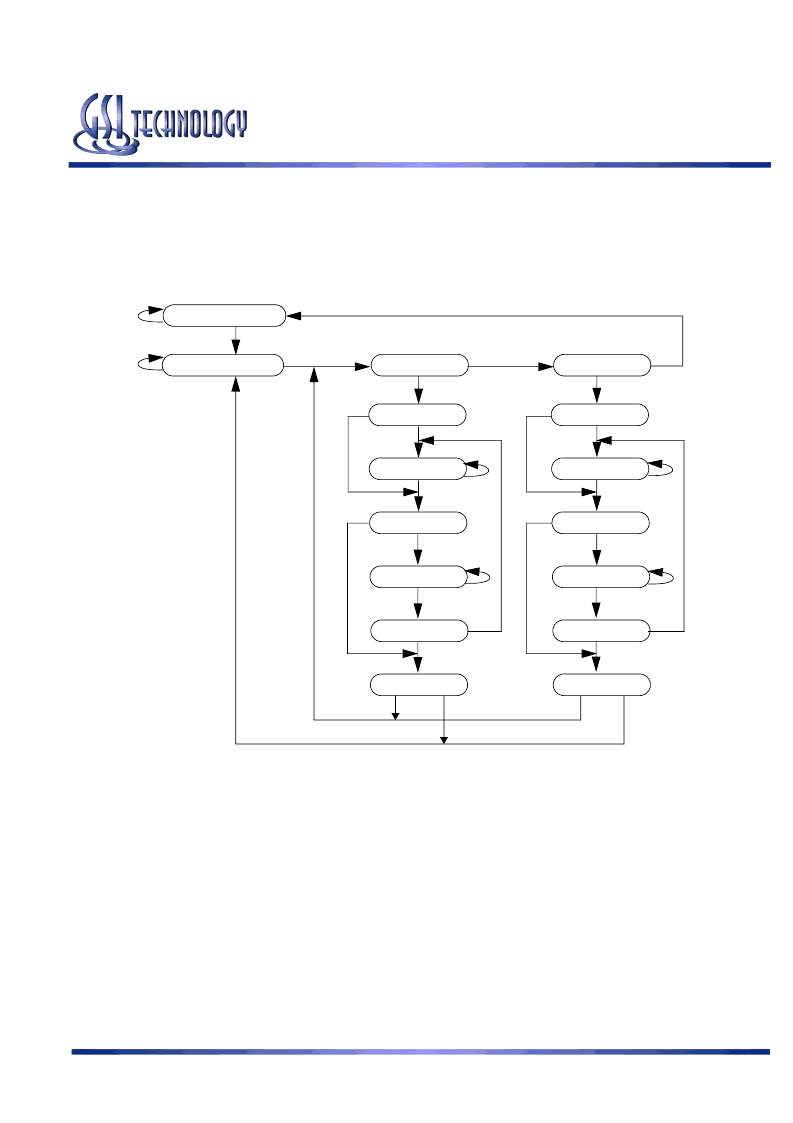- 您現(xiàn)在的位置:買(mǎi)賣(mài)IC網(wǎng) > PDF目錄385338 > GS8662S08E-200I (GSI TECHNOLOGY) 72Mb Burst of 2 DDR SigmaSIO-II SRAM PDF資料下載
參數(shù)資料
| 型號(hào): | GS8662S08E-200I |
| 廠商: | GSI TECHNOLOGY |
| 元件分類(lèi): | DRAM |
| 英文描述: | 72Mb Burst of 2 DDR SigmaSIO-II SRAM |
| 中文描述: | 8M X 8 DDR SRAM, 0.45 ns, PBGA165 |
| 封裝: | 15 X 17 MM, 1 MM PITCH, MO-216CAB-1, FPBGA-165 |
| 文件頁(yè)數(shù): | 29/37頁(yè) |
| 文件大小: | 960K |
| 代理商: | GS8662S08E-200I |
第1頁(yè)第2頁(yè)第3頁(yè)第4頁(yè)第5頁(yè)第6頁(yè)第7頁(yè)第8頁(yè)第9頁(yè)第10頁(yè)第11頁(yè)第12頁(yè)第13頁(yè)第14頁(yè)第15頁(yè)第16頁(yè)第17頁(yè)第18頁(yè)第19頁(yè)第20頁(yè)第21頁(yè)第22頁(yè)第23頁(yè)第24頁(yè)第25頁(yè)第26頁(yè)第27頁(yè)第28頁(yè)當(dāng)前第29頁(yè)第30頁(yè)第31頁(yè)第32頁(yè)第33頁(yè)第34頁(yè)第35頁(yè)第36頁(yè)第37頁(yè)

Preliminary
GS8662S08/09/18/36E-333/300/250/200/167
Specifications cited are subject to change without notice. For latest documentation see http://www.gsitechnology.com.
Rev: 1.01 9/2005
29/37
2005, GSI Technology
When the TAP controller is placed in Capture-IR state the two least significant bits of the instruction register are loaded with 01.
When the controller is moved to the Shift-IR state the Instruction Register is placed between TDI and TDO. In this state the desired
instruction is serially loaded through the TDI input (while the previous contents are shifted out at TDO). For all instructions, the
TAP executes newly loaded instructions only when the controller is moved to Update-IR state. The TAP instruction set for this
device is listed in the following table.
Select DR
Capture DR
0
Shift DR
Exit1 DR
Pause DR
Exit2 DR
Update DR
Select IR
Capture IR
0
Shift IR
Exit1 IR
Pause IR
Exit2 IR
Update IR
Test Logic Reset
Run Test Idle
0
1
0
1
1
0
1
1
1
0
0
1
1
0
0
0
0
1
1
0
0
1
1
0
0
0
1
1
1
1
JTAG Tap Controller State Diagram
Instruction Descriptions
BYPASS
When the BYPASS instruction is loaded in the Instruction Register the Bypass Register is placed between TDI and TDO. This
occurs when the TAP controller is moved to the Shift-DR state. This allows the board level scan path to be shortened to facili-
tate testing of other devices in the scan path.
SAMPLE/PRELOAD
SAMPLE/PRELOAD is a Standard 1149.1 mandatory public instruction. When the SAMPLE / PRELOAD instruction is
loaded in the Instruction Register, moving the TAP controller into the Capture-DR state loads the data in the RAMs input and
I/O buffers into the Boundary Scan Register. Boundary Scan Register locations are not associated with an input or I/O pin, and
are loaded with the default state identified in the Boundary Scan Chain table at the end of this section of the datasheet. Because
the RAM clock is independent from the TAP Clock (TCK) it is possible for the TAP to attempt to capture the I/O ring contents
while the input buffers are in transition (i.e. in a metastable state). Although allowing the TAP to sample metastable inputs will
not harm the device, repeatable results cannot be expected. RAM input signals must be stabilized for long enough to meet the
相關(guān)PDF資料 |
PDF描述 |
|---|---|
| GS8662S08E-250 | 72Mb Burst of 2 DDR SigmaSIO-II SRAM |
| GS8662S08E-250I | 72Mb Burst of 2 DDR SigmaSIO-II SRAM |
| GS8662S08E-300 | 72Mb Burst of 2 DDR SigmaSIO-II SRAM |
| GS8662S08E-300I | 72Mb Burst of 2 DDR SigmaSIO-II SRAM |
| GS8662S08E-333 | 72Mb Burst of 2 DDR SigmaSIO-II SRAM |
相關(guān)代理商/技術(shù)參數(shù) |
參數(shù)描述 |
|---|---|
| GS8662S08E-250 | 制造商:GSI 制造商全稱(chēng):GSI Technology 功能描述:72Mb Burst of 2 DDR SigmaSIO-II SRAM |
| GS8662S08E-250I | 制造商:GSI 制造商全稱(chēng):GSI Technology 功能描述:72Mb Burst of 2 DDR SigmaSIO-II SRAM |
| GS8662S08E-300 | 制造商:GSI 制造商全稱(chēng):GSI Technology 功能描述:72Mb Burst of 2 DDR SigmaSIO-II SRAM |
| GS8662S08E-300I | 制造商:GSI 制造商全稱(chēng):GSI Technology 功能描述:72Mb Burst of 2 DDR SigmaSIO-II SRAM |
| GS8662S08E-333 | 制造商:GSI 制造商全稱(chēng):GSI Technology 功能描述:72Mb Burst of 2 DDR SigmaSIO-II SRAM |
發(fā)布緊急采購(gòu),3分鐘左右您將得到回復(fù)。